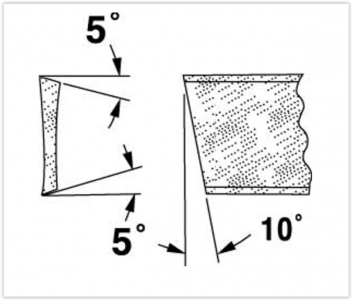- Joined
- Jul 20, 2014
- Messages
- 1,386
Emilio, if you go with HSS/cobalt blades, I suggest the P-type blades. This tool is built like a girder; it is very stiff and has a 5 degree side relief on each side to reduce binding in the cut. I sharpen mine similar to UlmaDoc except that I use a 7 degree nose relief and grind it flat across the face. Either way, his or mine, works and you should try both ways and see which works best for you. I use a 7 degree relief angle because I found it to be the best compromise when parting anything for which a HSS blade is appropriate. And yes, I ground and tested multiple angles to find my preferred angle. That doesn't mean it is right; it just means its right for me.
I also have an Aloris AXA-71 that takes GTN-3 inserts. This is huge blade (1.5" tall X 0.120" wide) that actually works well but the narrowest insert it takes is 1/8" wide. I use it when I cut harder stuff and have had no issues with it but there are smaller, narrower versions of this type of insert that I think would work better. Iscar makes more modern insert geometries; worth a look.
I also have an Aloris AXA-7 that will take HSS blades and smaller/narrower inserted blades. I don't like this tool much but it works okay if you get the blade perfectly vertical.
Sharpening a HSS tool is simple. Get the blade vertical in a tool holder, lay the holder on the side and rub the front of the tool against a sharpening stone while following the front relief angle. I prefer diamond stones but that is a personal preference. I stroke the blade only in the downward direction to avoid the tip from digging into the stone (which I have done all too many times). A few passes is sufficient to remove grinding marks and a pass or two on top to remove the burr and the tool is ready for use.
HSS parting tools need to be very sharp and used precisely on the centerline of the work and precisely perpendicular to the work. When parting from the front, keep your blade extension to a minimum. When parting from the rear, blade extension is not a major concern. When the tool cuts well, it only takes a slight positive feed to keep it cutting. That is, you should feel a slight positive resistance to the feed. Try to keep the feed consistent and the tool should part with no issues if the lathe is tight. In my experience, speeds should be whatever allows you to keep up a positive feed rate. Works for me anyway.
This is all good but I still can't see exactly where these relief grinds are made. I need a simple diagram or photo of the where the grinds are supposed to be. I don't mean to be thick, I just want to understand exactly where and how much. I have P type MoMax blades, HSS. Still looking for cobalt P type MoMax cut off tools. Thanks so much, everyone.



